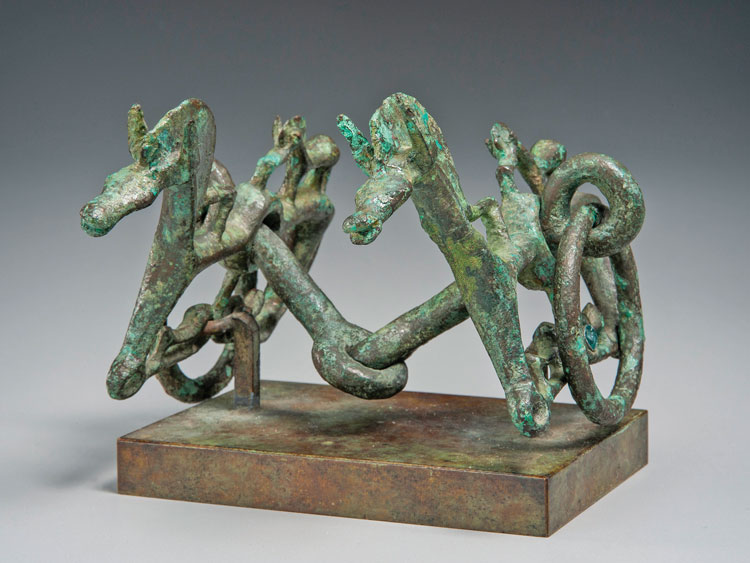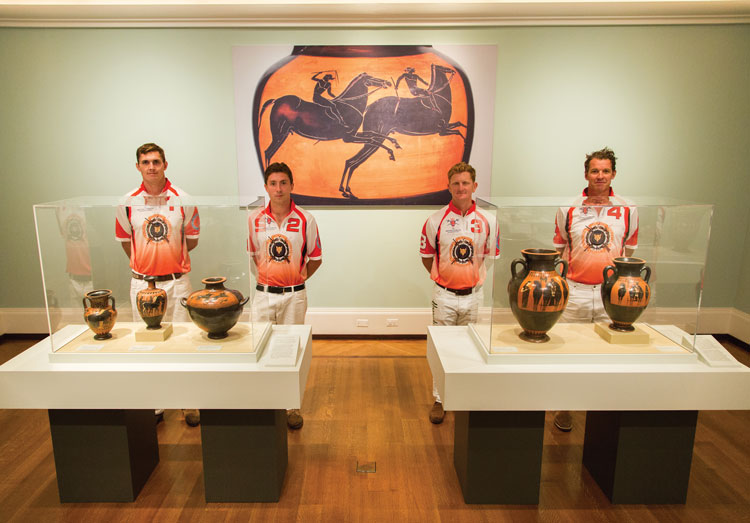The Horse In Ancient Greek Art

By Dulcy B. Hooper
“That snaffle bit hasn’t changed at all!” exclaimed one of the guests. “The ornamental cheekpiece might be a little different, but not the snaffle bit.”
The opening reception for The Horse in Ancient Greek Art took place at the National Sporting Library & Museum on September 9, 2017, attended by more than 200 guests sipping champagne and enjoying hors d’oeuvres on the lantern-lit terrace. There were many familiar Middleburg faces as well as numerous guests representing partner organizations from around the country.
Guests left their champagne glasses on tables set up immediately outside the doors to make forays into the museum. The exhibition is spread out over two floors, and the depictions of humans and horses inspired many observations that equestrian lifestyle has not changed much over the last few thousand years, with The Horse in Ancient Greek Art striking many parallels to the horsemanship of today.

The Horse in Ancient Greek Art features Greek vases, sculptures and coins from the 8th through the 4th centuries BCE. Both the exhibit and the accompanying publication explore the significance of the horse in ancient Greek culture, as well as imagery of the horse in ancient myth, war, sport and competition.
Black- and red-figure vases depict some of the earliest examples of the horse in Greek art, culture and mythology, beautifully illustrating ancient equestrian life. Chariot horses, jockeys, grooms tending to steeds—all celebrating ancient sport and competition. In addition to horses, the exhibition explores chariots and mythical horses such as Pegasus, as well as horse/human hybrids such as centaurs and satyrs.

The Horse in Ancient Greek Art was organized jointly by the National Sporting Library & Museum and the Virginia Museum of Fine Arts. Some of the objects on display are being exhibited for the first time, items drawn from private collections, the Virginia Museum of Fine Arts, the Tampa Museum of Art, the Metropolitan Museum of Art and other museum collections.
An accompanying exhibition catalog was published by the National Sporting Library & Museum in partnership with the Virginia Museum of Fine Arts and is being distributed by Yale University Press. The volume was edited by Nicole Stribling, curator of permanent collections at NSLM, and Peter Schertz, Virginia Museum of Fine Arts, who co-curated the exhibition. The catalog is illustrated with more than 80 objects depicting scenes of ancient equestrian life, interspersed with essays written by scholars exploring the significance of horses in myth, art, sport and competition.

The Horse in Ancient Greek Art will be on exhibit at the National Sorting Library & Museum through January 14, 2018. It will then travel to at the Virginia Museum of Fine Arts and will be on display from February 17, 2018 to July 8, 2018. Guided tours are available at NSLM, focusing on an exploration of ancient Greek culture, art, mythology, literature and equestrian topics.
For more information, contact Anne Marie Barnes at [email protected] or
540-687-6542 ext. 25. ML


